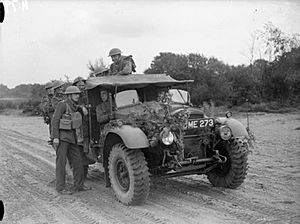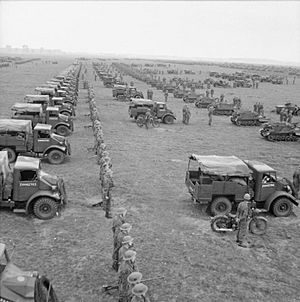Morris CS8 facts for kids
Quick facts for kids Morris Commercial CS8 |
|
|---|---|

GS truck and infantry section on a training exercise, Aldershot, November 1939
|
|
| Type | 15-cwt truck |
| Place of origin | United Kingdom |
| Service history | |
| Used by | British Commonwealth Germany (captured) |
| Wars | Second World War |
| Production history | |
| Designer | Morris Commercial Cars |
| Manufacturer | Morris Commercial Cars |
| Produced | 1934–1941 |
| No. built | 21,319 |
| Variants | GS cargo, water, fire tender, wireless, fuel tanker, "office" |
| Specifications (GS cargo body) | |
| Mass | 1 long ton 18 cwt 1 qr (4,280 lb or 1.94 t) |
| Length | 13 ft 10 in (4.22 m) 8 ft 2 in (2.49 m) wheelbase |
| Width | 6 ft 4 in (1.93 m) |
|
|
|
| Engine | 3,485 cm3 (212.7 cu in) 6-cylinder inline sidevalve petrol 60 bhp (45 kW) at 2,800 rpm |
| Payload capacity | 15 cwt |
| Drive | 4x2 |
| Transmission | 4F1R |
| Suspension | Multi-leaf semi-elliptical springs |
| Maximum speed | 40 mph (64 km/h) |
The Morris Commercial CS8, also known as the "Morris 15 cwt", was a British light military truck. It was used during the Second World War. This truck was first made in 1934. It was the most common truck of its size in the British Army when the war started. Later, other vehicles replaced it.
Contents
How Was the Morris CS8 Developed?
In 1933, the War Office (a British government department for the army) wanted a new type of light truck. This truck needed to carry about 15 hundredweight (which is about 762 kilograms) of supplies. The War Office asked for a truck with a short base between its wheels and good ground clearance. It also needed the driver's seat to be a bit forward. The goal was to use parts from regular commercial vehicles to make production easier.
The plan was for every army platoon (a small group of soldiers) to have one of these 15-cwt trucks. They would use it to carry soldiers and their equipment. Several companies, including Morris, Ford, Commer, Guy, and Bedford, offered their designs. In 1934, Morris was the first to create a design called the CS8. This truck used parts from Morris's everyday vehicles. The "S" in CS8 meant it had a 6-cylinder engine. The "8" referred to its wheelbase, which was about 8 feet long.
What Could the Morris CS8 Do?
The CS8 was a light truck with two-wheel drive (4x2). It was built to carry about 15 hundredweight (762 kg) of cargo. It had a 6-cylinder petrol engine that could produce 60 horsepower. This engine allowed the truck to go up to 40 miles per hour (about 64 km/h).
The truck's suspension used strong springs to help it handle rough roads. The standard cargo version of the CS8 weighed about 1.9 tonnes. It was about 4.2 meters long and 1.9 meters wide.
Early CS8 trucks had open cabs with small screens to block the wind. They also had canvas roofs that could be folded down and canvas doors that rolled up. Later versions had full windscreens and metal half-doors.
Different Types of Morris CS8 Trucks
The CS8 was made with many different body types. Most were 'General Service' cargo trucks, meaning they carried general supplies. But there were also special versions:
- Water Bowser: Carried water.
- Fire Tender: Used for fighting fires.
- Wireless Truck: Carried radio equipment for communication.
- Fuel Tanker: Carried fuel.
- Compressor Truck: Had an air compressor.
- Command Post ("Office") Truck: Used as a mobile office for commanders.
There was even a special version that carried a 2-pounder (40mm) anti-tank gun on its back. This was called a 'portee' truck.
Some of the longer and heavier versions, like the wireless truck, had problems with handling. This was because their bodies were too long for the standard wheelbase.
There was also a smaller version called the PU8. It could carry about 8 hundredweight (406 kg) of cargo. It had the same engine as the CS8 but performed better. A four-wheel drive (4x4) version of the PU8 was also made, called the PU8/4.
Where Was the Morris CS8 Used?
Before the Second World War, the CS8 was the most common 15-cwt truck in the British Army. It was used by all parts of the British military. It was also sent to countries in the British Commonwealth.
During the war, many CS8 trucks were left behind in France after the Dunkirk evacuation. These trucks were captured by the Germans. The German army (called the Wehrmacht) sometimes changed the bodywork of these captured trucks. The Italian army also captured some CS8s in North Africa and fitted them with their own cannons.
In 1941, Morris stopped making the CS8. They started making a similar truck called the C4 model. The C4 had a 4-cylinder engine and a longer wheelbase (about 2.7 meters). This longer wheelbase helped fix the handling problems of the CS8. The army also decided they no longer needed 8-cwt trucks, so production of the PU8 stopped in 1941 as well.
A longer version of the CS8 frame was used to build the Morris CS9 armoured car.
Variants
- Mark I
- Mark II
- Mark III


